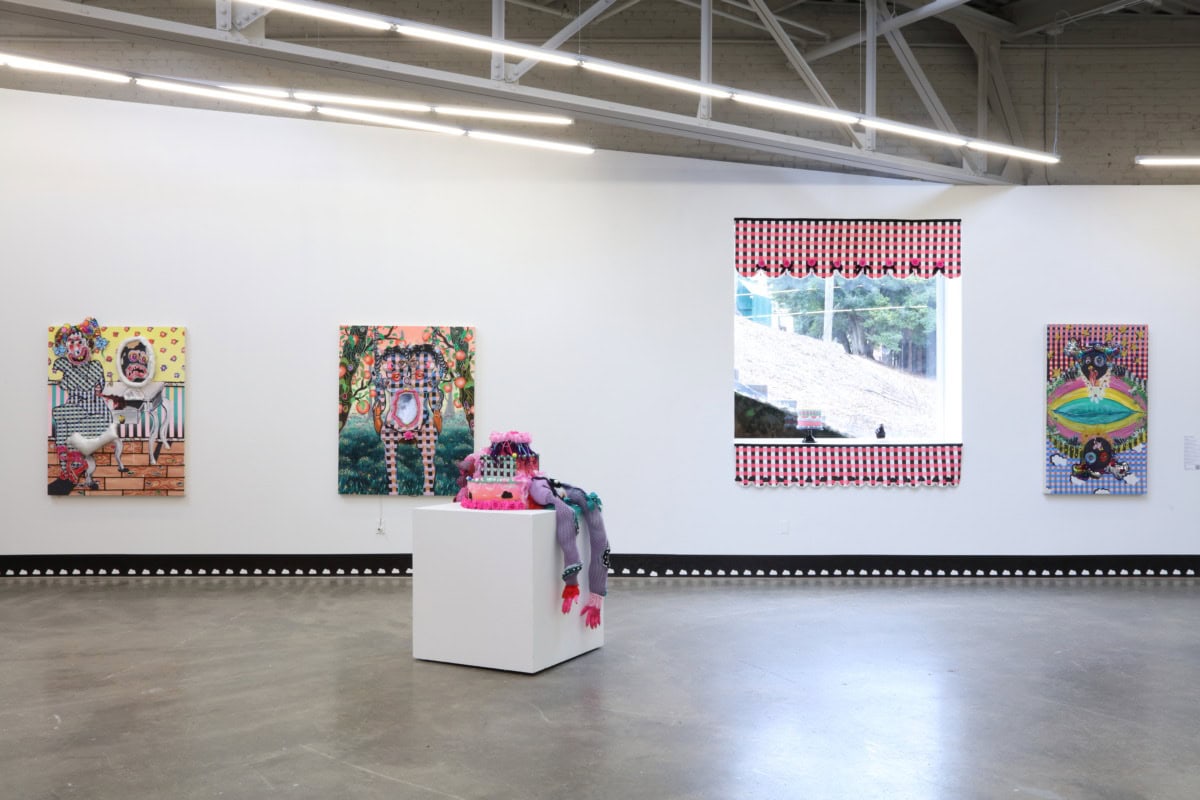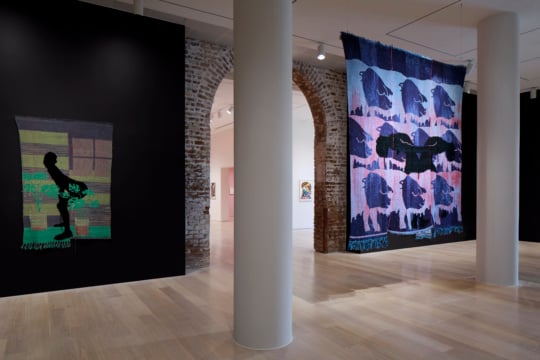
Patterning, appliquéd objects, and glitter adorn Black figures as they morph, dissolve, and distort within their settings. Simultaneously grotesque and beautiful, Victoria Dugger’s artworks depict the artist’s lived experience as a Black, disabled woman. Employing painting and sculpture, Dugger creates slices-of-life that capture the ways in which marginalized individuals are flattened, ostracized, and stereotyped. I first wrote about Dugger’s artworks in 2021—a review of her exhibition at Lyndon House Arts Center in Athens, GA. In that exhibition, her artworks depicted figures within domestic settings only. However, at my next opportunity to see her work in person, the group exhibition New Worlds: Georgia Women to Watch at Atlanta Contemporary in 2023, her figures have moved outdoors. I met with Dugger over video conference to discuss the ways her figures are abstracted, misshaped, or obscured, and how these visual motifs both camouflage and exaggerate aspects of her identity. This conversation was edited for length and publication.
Leia Genis: So, a lot of the paintings have a lot of appliqued materials on top of them. They end up being somewhere in between a painting and a sculpture. What role do these appliqued materials play in your paintings?
Victoria Dugger: I love painting, but I am low-key bored by it. Sculpture is just so exciting to me. I hadn’t been painting for a long time before grad school and I was like “You know what? I really want to get back into painting. I don’t really know how to approach it again.” Conceptually, I talk a lot about being Black and disabled, and being a woman. And I feel like all of that relates to how marginalized people are viewed by society as really flat, two-dimensional individuals. So, I don’t know if it’s an extremely elegant thought to be like, “Okay, I am going to put appliqued materials on the figures themselves.” I think it was not so much tactical but a very blunt way for me to do that. It kind of got the ball rolling from there because I realized I could use glitter to create a distinction between the layers. I love flat perspective but I was trying to separate the layers so they look a little more interesting and stood out from the background. But again, wanted there to be something three-dimensional, and that may be an elementary way of getting there.

LG: One of the things that you were just saying is that you’re using different materials, specifically glitter, as a way to differentiate the layers. But a lot of the figures that you paint are patterned over. Thinking of more traditional painting techniques, they are very accurately trying to describe the three-dimensional form. But the patterning you use very much flattens them. And to my mind that seems to work in opposition to the glitter you are using to distinguish the layers. So, what does the patterning on the skin do in relation to this distinction of layers and forms?
VD: I think it calls back to that optical illusion. I think I’m just attracted to that—something being drawn in that kind of traditional way and then having that flat pattern over top. I really loved Matisse. I think it’s coming from there as well. With the mirror piece, The Devil Makes Three, I really wanted to think about the pearl imagery, and I use the gingham pattern that’s kind of become my go-to. The figure in that piece was very three-dimensional. I think it really added to the optical illusion. The flat figure that I usually use but then having that raised element, I think it brings the viewer in more. It gets them a little closer. It’s kind of a seduction technique.
LG: I was just thinking that. I am thinking of flowers—how they intentionally use colors or patterns to draw something in. But that’s always with the intent of bringing pollinators to then spread the pollen. It’s a very essential reproductive thing. I wonder if there is a second side or a desired outcome for you. You’ve used these patterns and objects to draw the viewer in. I wonder if there is a desired result from this interaction.
VD: I think so because a lot of times my imagery can get really grotesque. There is this push and pull. “Ooh I want you to come closer” and then I kind of, “Ooh I want you to go away.” I want you to be aware of your own repulsion. I have thought about that before and what are the things we consider beautiful, what we want to be close to. And then what do people find grotesque or what repels us. As a disabled person, I have become more aware of that. I get stares at the grocery store and its this weird thing because you’re looking at me but it’s not because you like my hair or something.
LG: It’s an ostracizing way of looking.
VD: Yeah! In a weird way, art is all about looking. Well, not in a weird way, but that we look or stare. What’s the difference between gazing and staring?

LG: That’s an interesting distinction, between gazing and staring. What’s a malicious gaze and what’s a friendly gaze? Because externally they look the same—someone standing, mostly still—but it’s different intentions with both. Reflection appears in some of your work. This reflection, is that your way of looking inward or is that your way of making the viewer aware that they are staring?
VD: I think both. Especially in The Devil Makes Three, I was like, “Okay, maybe I can draw a mirror.” But I thought it would be so funny if I just hung a mirror on it. I think I just like to make myself laugh sometimes.
LG: I think that’s very important!
VD: Yeah exactly! I was like, “Oh they could catch glimpses of themselves.” But then there is this thing that is obscuring them. It almost becomes an exquisite corpse. But as a disabled person, when I go to use the bathrooms, I can never see myself because the mirrors are so high. And that’s something I don’t know if even I realized until a moment one day. I never see myself out in the world where there normally would be reflections. I was doing a lot of reading, as one does in grad school, for better or for worse (laughter). And we read this book for Disability Studies—which I failed. I failed Disability Studies.

LG: Wow (laughter)
VD: Right! But the person who wrote the book was theorizing that disabled people are very inward looking, very selfish. Because their chronic pain often times leads them to be narcissistic because they are so consumed. You are consumed by yourself and your inward pain that it is often difficult for you to look outward.
LG: Okay. Not sure I agree with that claim.
VD: Yeah. But I was like, “Am I a narcissist?” So, I started thinking about narcissists and that painting by Caravaggio, how the person fell in love with their reflection. And I was like, “What a beautiful privilege to have.” To be so enamored with yourself that you fall in love with yourself…
LG: So, in your paintings, you often depict these figures in domestic settings. Is that because you feel so comfortable in domestic settings?
VD: I think so. I had a great childhood; my brothers would play with me all the time. Even though they were 5 years older than me, they really took the time to hang out with me. And again, I think with domestication there are these expectations of women and in a way my disability has allowed me to swerve them a little bit. So, it’s interesting to not have the expectation that you’re a mother. Not that I necessarily want those things but now that I am 31 all my friends are getting married and all those things and I am just hanging out with my cat (laughter).When I put my figures outside, I think nature is an equal playing field. I think of that as a no holds barred. The wilderness is such an opposite of the beautiful domestic Southern setting where everything needs to be perfect. Anything goes outside.




